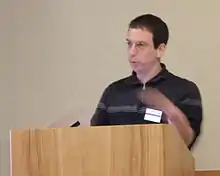Dan Boneh
Dan Boneh (* 1969 in Israel) ist ein israelisch-US-amerikanischer Informatiker und Kryptologe.

Boneh wurde 1996 an der Princeton University bei Richard J. Lipton promoviert (Studies in computational number theory with applications to cryptography).[1] Er ist Professor an der Stanford University. Er leitete dort die Gruppe Angewandte Kryptographie.
Er arbeitet auf dem Gebiet der Kryptologie und Computer-Sicherheit und entwickelte neue Systeme für Internet-Sicherheit (tcpcrypt[2]), PwdHash für Browser und kryptographische Wasserzeichen. Er befasste sich mit Kryptanalyse von Public-Key-Systemen wie RSA, mit dem Decisional-Diffie-Hellman-Problem und 1995 mit Kryptanalyse mit DNA-Computern (mit Lipton).
Mit Matthew K. Franklin entwickelte er 2001 identitätsbasierte Verschlüsselungsmechanismen[3] basierend auf Weil-Paarung Elliptischer Kurven (Franklin-Boneh-Verfahren).[4][5]
2003 veröffentlichte er mit David Brumley einen Timing-Attack auf OpenSSL[6] und später auf andere Web-Applikationen.[7]
2009 erhielt er den Gödel-Preis mit Franklin für Identity based encryption from the Weil pairing und 2014 erhielt er den ACM Infosys Award. Er war Packard und Sloan Research Fellow. Er ist Mitgründer von Voltage Security. 2016 wurde er in die National Academy of Engineering und zum Fellow der Association for Computing Machinery gewählt, 2023 zum Mitglied der National Academy of Sciences.
Zu seinen Doktoranden gehört Craig Gentry.
Einzelnachweise
- Dan Boneh im Mathematics Genealogy Project (englisch)
- Cryptographic Protection of TCP-Streams
- ID-based encryption (IBE). Eingeführt von Adi Shamir 1984. Bei ihnen werden Identitätsinformationen (wie Name, E-Mail-Adresse) etc. des Nutzers als öffentlicher Schlüssel verwendet.
- Dan Boneh, Matthew K. Franklin, Identity-Based Encryption from the Weil Pairing, Advances in Cryptology - Proceedings of CRYPTO 2001
- Boneh, Franklin, Identity based encryption from the Weil pairing, SIAM J. of Computing, Band 32, 2003, S. 586–615
- Boneh, Brumley Remote timing attacks are practical, Proceedings of the 12th Usenix Security Symposium, 2003
- A. Bortz, D. Boneh, P. Nandy Exposing private information by timing web applications, Proceedings of the 16th International Conference on World Wide Web, WWW 2007, ACM 2007, S. 621–628